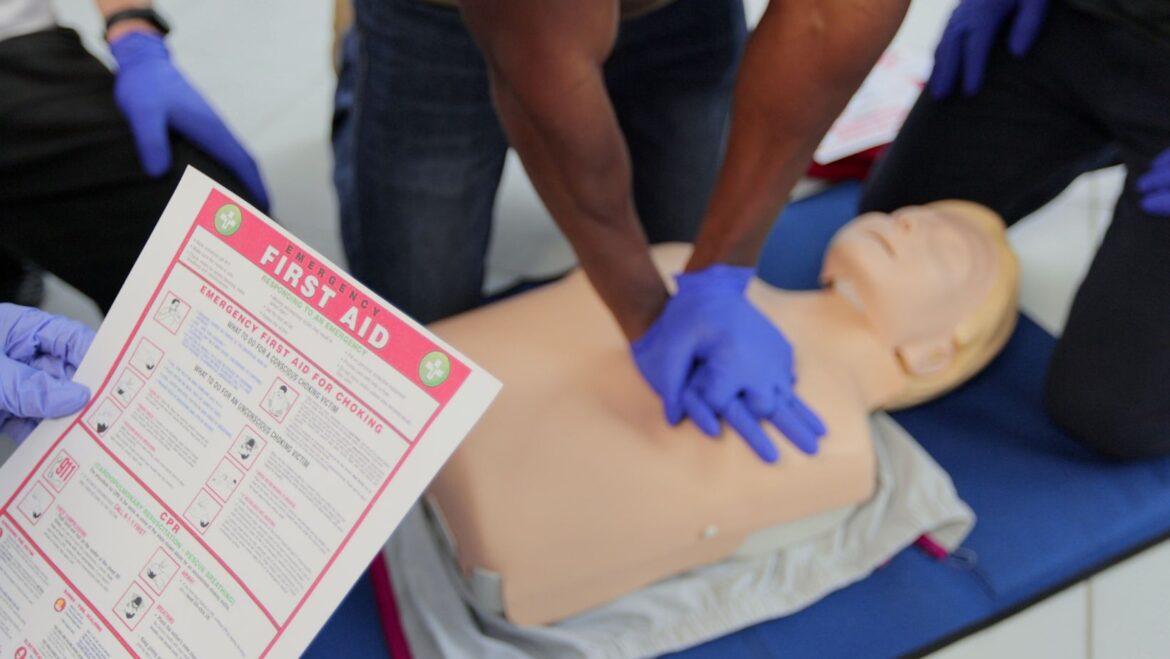Introduction
Accidents and emergencies can happen anywhere and at any time, from home to the workplace or even on the street. Knowing what to do in these situations can make a significant difference, and that’s where first aid training comes in. In 2022, there were about 2.6 million nonfatal workplace injuries and illnesses reported in the private sector in the United States, according to the U.S. Bureau of Labor Statistics. Many of these injuries could benefit from immediate first aid.
First aid certification provides you with the knowledge and skills needed to respond effectively in an emergency, offering assistance before professional help arrives. Whether it’s treating minor injuries or providing crucial support during a life-threatening situation, being first aid certified empowers you to take action when it matters most.
What is First Aid Certification?
First aid certification is a credential that shows you have been trained in basic emergency care. This certification is usually obtained by completing a course that teaches you how to handle different types of medical emergencies until professional help arrives. The goal is to equip you with the skills needed to respond confidently and effectively when someone is injured or unwell.
Here are some key points about first aid certification:
- Covers Essential Skills: You will learn how to handle common emergencies, including treating wounds, burns, sprains, and performing CPR. The training also covers how to assist someone who is choking or having a heart attack.
- Short and Accessible: Most first aid courses are short, often lasting just a few hours or up to a couple of days. They are designed to be accessible to everyone, regardless of prior medical knowledge.
- Hands-On Practice: The training usually includes practical sessions where you can practice what you’ve learned on mannequins or through role-playing scenarios. This hands-on approach helps you feel more prepared to act in real-life situations.
- Certification Validity: Once you complete the course, you receive a certification that is typically valid for two to three years. After that, a refresher course is recommended to keep your skills sharp and up to date.
- Boosts Confidence and Preparedness: Beyond just learning skills, getting certified helps you feel more confident in your ability to handle emergencies, whether at home, work, or in your community.
Steps to get First Aid Certified
Getting first aid certified is a straightforward process that involves finding the right course, attending the training, and passing an assessment. Whether you’re doing it for a job requirement, personal interest, or to be better prepared for emergencies, the steps are easy to follow and designed to make sure you gain the necessary skills.
Here’s how you can get first aid certified:
- Choose a Course: Start by selecting a course from a reputable provider. Make sure the course content fits your needs, whether it’s basic first aid, CPR, or a more comprehensive package.
- Register for the Course: Once you’ve chosen a course, you’ll need to register. This can usually be done online, by phone, or in person. You may need to select a date and location that works for your schedule, and some courses also offer online options for the theoretical part, with in-person sessions for practical training.

- Attend the Training: Participate in the training sessions, which will include both classroom learning and hands-on practice. Be prepared to engage in activities like performing CPR on mannequins, learning how to bandage wounds, and practicing the recovery position.
- Pass the Assessment: To earn your certification, you’ll need to pass a final assessment, which may include both a written test and a practical demonstration of your skills. Don’t worry—these assessments are designed to ensure you understand the basics and can apply them when needed.
- Receive Your Certification: After successfully completing the course and passing the assessments, you’ll receive your first aid certification. This can be provided as a physical certificate, a digital copy, or both. Keep this document safe, as it serves as proof of your training.
- Stay Up to Date: First aid certifications are typically valid for two to three years. To keep your certification current, plan to take a refresher course before it expires. This will help you stay prepared and updated on any new guidelines or techniques.
Benefits of First Aid Certification
Enrolling in a first aid certification course will help you understand how to respond to emergencies and bring many benefits that make it worth considering. Here’s why taking a first aid course is a smart choice:
- Immediate Response Skills: Learn how to act quickly and effectively in emergencies, potentially saving lives during critical moments.
- Increased Confidence: Gain the confidence to handle medical situations calmly and efficiently, which can reduce anxiety in high-pressure scenarios.
- Enhanced Safety: Improve safety at home, in the workplace, and in public by being prepared for injuries and emergencies.
- Professional Advantages: Many jobs and volunteer positions require or prefer First Aid certification, making you a more competitive candidate.
- Compliance with Regulations: Meet occupational health and safety requirements that may be mandated for certain roles or organizations.
Wrapping Up
Obtaining a first aid certification is a valuable investment in both personal and professional development. You can learn these skills through certification courses or practice drills. The great thing is that anyone, regardless of age or experience, can take part in this training. This certification can be useful at home, in the workplace, or out in the community, making it a practical skill set that.





